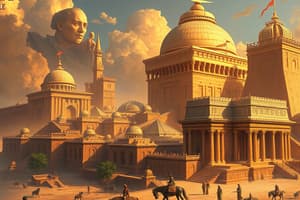Podcast
Questions and Answers
What consequence is described for a slave that strikes its owner?
What consequence is described for a slave that strikes its owner?
- The slave's ear will be cut off (correct)
- The slave will be set free
- The owner will be fined
- The slave will be imprisoned
What measure is taken if someone does not properly maintain a dam?
What measure is taken if someone does not properly maintain a dam?
- They shall be punished by drowning
- They are exiled from the community
- They must pay a penalty in crops
- They will be sold for money to cover damages (correct)
How was the Assyrian Empire characterized in terms of military capability?
How was the Assyrian Empire characterized in terms of military capability?
- It relied primarily on mercenaries
- It avoided warfare and focused on trade
- It was the most disciplined army of its time (correct)
- It was known for its naval prowess
What was a significant action taken by the Assyrian army under Ashurbanipal?
What was a significant action taken by the Assyrian army under Ashurbanipal?
In the governance structure of the Assyrian Empire, how were provinces managed?
In the governance structure of the Assyrian Empire, how were provinces managed?
What was the main reason for the weakening of Sumer's city-states by 2400 B.C.?
What was the main reason for the weakening of Sumer's city-states by 2400 B.C.?
Who is known for uniting Sumer and Akkad to form the first empire?
Who is known for uniting Sumer and Akkad to form the first empire?
What was Babylon known for during the rule of Hammurabi?
What was Babylon known for during the rule of Hammurabi?
What does the phrase 'an eye for an eye, and a tooth for a tooth' in the Code of Hammurabi imply?
What does the phrase 'an eye for an eye, and a tooth for a tooth' in the Code of Hammurabi imply?
Which of the following was a social inequality reflected in the Code of Hammurabi?
Which of the following was a social inequality reflected in the Code of Hammurabi?
What would happen if a builder constructed a house poorly and it resulted in a death?
What would happen if a builder constructed a house poorly and it resulted in a death?
What protection did the laws under Hammurabi provide for wives?
What protection did the laws under Hammurabi provide for wives?
What was a limitation placed on women in Babylonian society as per the Code of Hammurabi?
What was a limitation placed on women in Babylonian society as per the Code of Hammurabi?
Flashcards
Sumerian city-states
Sumerian city-states
Independent city-states in Mesopotamia lacking a unified government, frequently warring.
Akkad
Akkad
A city in Northern Mesopotamia, ruled by Sargon who formed the first empire.
First Empire
First Empire
The Akkadian Empire, unified Sumer and Akkad, around 2300 BC.
Amorites
Amorites
Signup and view all the flashcards
Babylonian Empire
Babylonian Empire
Signup and view all the flashcards
Code of Hammurabi
Code of Hammurabi
Signup and view all the flashcards
Assyrian Empire
Assyrian Empire
Signup and view all the flashcards
Nineveh
Nineveh
Signup and view all the flashcards
King Ashurbanipal
King Ashurbanipal
Signup and view all the flashcards
Assyrian military
Assyrian military
Signup and view all the flashcards
Assyrian administrative system
Assyrian administrative system
Signup and view all the flashcards
Retributive justice
Retributive justice
Signup and view all the flashcards
Societal Inequalities
Societal Inequalities
Signup and view all the flashcards
Study Notes
Sumer and its Downfall
- Sumerian city-states lacked a strong, united government, leading to frequent conflicts over land and water rights.
- By 2400 B.C., ongoing wars weakened the city-states significantly.
Akkadian Empire
- Akkad, located in Northern Mesopotamia, was led by Sargon, who united Sumer and Akkad around 2300 B.C.
- This unification formed the first known empire, which lasted over 200 years.
- The Amorites, inhabiting regions west of Mesopotamia, eventually overtook this area and built significant cities; Babylon was the largest.
Babylonian Empire
- Hammurabi became king of Babylon, conquering Amorite cities and establishing the Babylonian Empire.
- The Code of Hammurabi was a comprehensive set of laws that included explicit punishments for various crimes, embodying the principle of retributive justice: “an eye for an eye, and a tooth for a tooth.”
- The code revealed societal inequalities, with nobles and priests facing lighter punishments than commoners, and women having fewer rights though some could own property and testify in court.
- Protective laws existed for women, ensuring security from abuse and compensation upon divorce, but could also enforce harsh conditions, such as forced slavery for debts.
- Detailed punishments included death for improperly built homes that collapsed, reciprocal physical injuries for assaults, and severe consequences for property destruction.
Assyrian Empire
- The Assyrians, also in Northern Mesopotamia, developed a formidable army by around 900 B.C., initiating the conquest of Mesopotamia.
- Nineveh served as the capital of the Assyrian Empire.
- Under King Ashurbanipal, the empire exerted control through military force, burning crops and coercing payments from conquered peoples.
- The Assyrian military was highly disciplined, recognized for its artistry in warfare.
- The empire's administrative structure included provinces governed by local rulers appointed by the king, connected through an extensive road network.
Studying That Suits You
Use AI to generate personalized quizzes and flashcards to suit your learning preferences.




